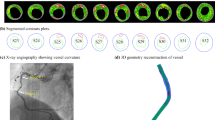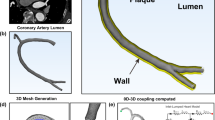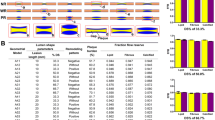Abstract
Asymptomatic vulnerable plaques (VP) in coronary arteries accounts for significant level of morbidity. Their main risk is associated with their rupture which may prompt fatal heart attacks and strokes. The role of microcalcifications (micro-Ca), embedded in the VP fibrous cap, in the plaque rupture mechanics has been recently established. However, their diminutive size offers a major challenge for studying the VP rupture biomechanics on a patient specific basis. In this study, a highly detailed model was reconstructed from a post-mortem coronary specimen of a patient with observed VP, using high resolution micro-CT which captured the microcalcifications embedded in the fibrous cap. Fluid–structure interaction (FSI) simulations were conducted in the reconstructed model to examine the combined effects of micro-Ca, flow phase lag and plaque material properties on plaque burden and vulnerability. This dynamic fibrous cap stress mapping elucidates the contribution of micro-Ca and flow phase lag VP vulnerability independently. Micro-Ca embedded in the fibrous cap produced increased stresses predicted by previously published analytical model, and corroborated our previous studies. The ‘micro-CT to FSI’ methodology may offer better diagnostic tools for clinicians, while reducing morbidity and mortality rates for patients with vulnerable plaques and ameliorating the ensuing healthcare costs.





Similar content being viewed by others
References
ADINA. ADINA Manual, Theory and Modeling Guide: ARD 09-7, 2009.
Alsheikh-Ali, A. A., G. D. Kitsios, E. M. Balk, J. Lau, and S. Ip. The vulnerable atherosclerotic plaque: scope of the literature. Ann. Intern. Med. 153:387–395, 2010.
Bluestein, D., Y. Alemu, I. Avrahami, M. Gharib, K. Dumont, J. J. Ricotta, and S. Einav. Influence of microcalcifications on vulnerable plaque mechanics using FSI modeling. J. Biomech. 41:1111–1118, 2008.
Bobryshev, Y. V., M. C. Killingsworth, R. S. Lord, and A. J. Grabs. Matrix vesicles in the fibrous cap of atherosclerotic plaque: possible contribution to plaque rupture. J. Cell Mol. Med. 12:2073–2082, 2008.
Burke, A. P., A. Farb, G. T. Malcom, Y. H. Liang, J. Smialek, and R. Virmani. Coronary risk factors and plaque morphology in men with coronary disease who died suddenly. N. Engl. J. Med. 336:1276–1282, 1997.
Burke, A. P., A. Farb, G. T. Malcom, Y. Liang, J. Smialek, and R. Virmani. Effect of risk factors on the mechanism of acute thrombosis and sudden coronary death in women. Circulation 97:2110–2116, 1998.
Burke, A. P., D. K. Weber, F. D. Kolodgie, A. Farb, A. J. Taylor, and R. Virmani. Pathophysiology of calcium deposition in coronary arteries. Herz 26:239–244, 2001.
Cheng, G. C., H. M. Loree, R. D. Kamm, M. C. Fishbein, and R. T. Lee. Distribution of circumferential stress in ruptured and stable atherosclerotic lesions—a structural-analysis with histopathological correlation. Circulation 87:1179–1187, 1993.
Cheng, C., D. Tempel, R. van Haperen, A. van der Baan, F. Grosveld, M. J. Daemen, R. Krams, and R. de Crom. Atherosclerotic lesion size and vulnerability are determined by patterns of fluid shear stress. Circulation 113:2744–2753, 2006.
Gent, A. N., and B. Park. Failure processes in elastomers at or near a rigid spherical inclusion. J. Mater. Sci. 19:1947–1956, 1984.
Hayashi, K., Y. Igarashi, and K. Takamizawa. Mechanical properties and hemodynamics in coronary arteries. In: New Approaches in Cardiac Mechanics, edited by K. Kitamura, H. Abe, and K. Sagawa. Tokyo: Gorden and Breach, 1986, pp. 285–294.
Holzapfel, G. A. Nonlinear Solid Mechanics: A Continuum Approach for Engineering. New York: Wiley, 2000.
Holzapfel, G. A., G. Sommer, C. T. Gasser, and P. Regitnig. Determination of layer-specific mechanical properties of human coronary arteries with nonatherosclerotic intimal thickening and related constitutive modeling. Am. J. Physiol. Heart Circ. Physiol. 289:H2048–H2058, 2005.
Holzapfel, G. A., G. Sommer, and P. Regitnig. Anisotropic mechanical properties of tissue components in human atherosclerotic plaques. J. Biomech. Eng. 126:657–665, 2004.
Holzapfel, G. A., M. Stadler, and C. A. Schulze-Bauer. A layer-specific three-dimensional model for the simulation of balloon angioplasty using magnetic resonance imaging and mechanical testing. Ann. Biomed. Eng. 30:753–767, 2002.
Huang, H., R. Virmani, H. Younis, A. P. Burke, R. D. Kamm, and R. T. Lee. The impact of calcification on the biomechanical stability of atherosclerotic plaques. Circulation 103:1051–1056, 2001.
Imoto, K., T. Hiro, T. Fujii, A. Murashige, Y. Fukumoto, G. Hashimoto, T. Okamura, J. Yamada, K. Mori, and M. Matsuzaki. Longitudinal structural determinants of atherosclerotic plaque vulnerability—a computational analysis of stress distribution using vessel models and three-dimensional intravascular ultrasound imaging. J. Am. Coll. Cardiol. 46:1507–1515, 2005.
Kajiya, F., K. Tsujioka, Y. Ogasawara, Y. Wada, S. Matsuoka, S. Kanazawa, O. Hiramatsu, S. Tadaoka, M. Goto, and T. Fujiwara. Analysis of flow characteristics in poststenotic regions of the human coronary artery during bypass graft surgery. Circulation 76:1092–1100, 1987.
Libby, P. Molecular bases of the acute coronary syndromes. Circulation 91:2844–2850, 1995.
Liu, B., and D. Tang. Influence of non-Newtonian properties of blood on the wall shear stress in human atherosclerotic right coronary arteries. Mol. Cell. Biomech. 8:73–90, 2011.
Lloyd-Jones, D., R. J. Adams, T. M. Brown, M. Carnethon, S. Dai, G. De Simone, T. B. Ferguson, E. Ford, K. Furie, C. Gillespie, A. Go, K. Greenlund, N. Haase, S. Hailpern, P. M. Ho, V. Howard, B. Kissela, S. Kittner, D. Lackland, L. Lisabeth, A. Marelli, M. M. McDermott, J. Meigs, D. Mozaffarian, M. Mussolino, G. Nichol, V. L. Roger, W. Rosamond, R. Sacco, P. Sorlie, T. Thom, S. Wasserthiel-Smoller, N. D. Wong, and J. Wylie-Rosett. Heart disease and stroke statistics—2010 update: a report from the American Heart Association. Circulation 121:e46–e215, 2010.
Marques, K. M., H. J. Spruijt, C. Boer, N. Westerhof, C. A. Visser, and F. C. Visser. The diastolic flow-pressure gradient relation in coronary stenoses in humans. J. Am. Coll. Cardiol. 39:1630–1636, 2002.
Naghavi, M., P. Libby, E. Falk, S. W. Casscells, S. Litovsky, J. Rumberger, J. J. Badimon, C. Stefanadis, P. Moreno, G. Pasterkamp, Z. Fayad, P. H. Stone, S. Waxman, P. Raggi, M. Madjid, A. Zarrabi, A. Burke, C. Yuan, P. J. Fitzgerald, D. S. Siscovick, C. L. de Korte, M. Aikawa, K. E. Airaksinen, G. Assmann, C. R. Becker, J. H. Chesebro, A. Farb, Z. S. Galis, C. Jackson, I. K. Jang, W. Koenig, R. A. Lodder, K. March, J. Demirovic, M. Navab, S. G. Priori, M. D. Rekhter, R. Bahr, S. M. Grundy, R. Mehran, A. Colombo, E. Boerwinkle, C. Ballantyne, W. Insull, Jr., R. S. Schwartz, R. Vogel, P. W. Serruys, G. K. Hansson, D. P. Faxon, S. Kaul, H. Drexler, P. Greenland, J. E. Muller, R. Virmani, P. M. Ridker, D. P. Zipes, P. K. Shah, and J. T. Willerson. From vulnerable plaque to vulnerable patient: a call for new definitions and risk assessment strategies: Part II. Circulation 108:1772–1778, 2003.
Naghavi, M., P. Libby, E. Falk, S. W. Casscells, S. Litovsky, J. Rumberger, J. J. Badimon, C. Stefanadis, P. Moreno, G. Pasterkamp, Z. Fayad, P. H. Stone, S. Waxman, P. Raggi, M. Madjid, A. Zarrabi, A. Burke, C. Yuan, P. J. Fitzgerald, D. S. Siscovick, C. L. de Korte, M. Aikawa, K. E. Juhani Airaksinen, G. Assmann, C. R. Becker, J. H. Chesebro, A. Farb, Z. S. Galis, C. Jackson, I. K. Jang, W. Koenig, R. A. Lodder, K. March, J. Demirovic, M. Navab, S. G. Priori, M. D. Rekhter, R. Bahr, S. M. Grundy, R. Mehran, A. Colombo, E. Boerwinkle, C. Ballantyne, W. Insull, Jr., R. S. Schwartz, R. Vogel, P. W. Serruys, G. K. Hansson, D. P. Faxon, S. Kaul, H. Drexler, P. Greenland, J. E. Muller, R. Virmani, P. M. Ridker, D. P. Zipes, P. K. Shah, and J. T. Willerson. From vulnerable plaque to vulnerable patient: a call for new definitions and risk assessment strategies: Part I. Circulation 108:1664–1672, 2003.
Richardson, P. D., M. J. Davies, and G. V. R. Born. Influence of Plaque Configuration and Stress Distribution on Fissuring of Coronary Atherosclerotic Plaques. Lancet 2:941–944, 1989.
Rodriguez, J. F., C. Ruiz, M. Doblare, and G. A. Holzapfel. Mechanical stresses in abdominal aortic aneurysms: influence of diameter, asymmetry, and material anisotropy. J. Biomech. Eng. 130:021023, 2008.
Saba, L., F. Potters, A. van der Lugt, and G. Mallarini. Imaging of the fibrous cap in atherosclerotic carotid plaque. Cardiovasc. Intervent. Radiol. 33:681–689, 2010.
Samady, H., P. Eshtehardi, M. C. McDaniel, J. Suo, S. S. Dhawan, C. Maynard, L. H. Timmins, A. A. Quyyumi, and D. P. Giddens. Coronary artery wall shear stress is associated with progression and transformation of atherosclerotic plaque and arterial remodeling in patients with coronary artery disease. Circulation 124:779–788, 2011.
Sussman, T., and K. J. Bathe. A finite-element formulation for nonlinear incompressible elastic and inelastic analysis. Comput. Struct. 26:357–409, 1987.
Tang, D., C. Yang, S. Kobayashi, and D. N. Ku. Effect of a lipid pool on stress/strain distributions in stenotic arteries: 3-D fluid–structure interactions (FSI) models. J. Biomech. Eng. 126:363–370, 2004.
Tang, D., C. Yang, S. Kobayashi, J. Zheng, P. K. Woodard, Z. Teng, K. Billiar, R. Bach, and D. N. Ku. 3D MRI-based anisotropic FSI models with cyclic bending for human coronary atherosclerotic plaque mechanical analysis. J. Biomech. Eng. 131:061010, 2009.
Tang, D., C. Yang, H. Walker, S. Kobayashi, and D. N. Ku. Simulating cyclic artery compression using a 3D unsteady model with fluid–structure interactions. Comput. Struct. 80:1651–1665, 2002.
Tang, D., C. Yang, J. Zheng, P. K. Woodard, J. E. Saffitz, J. D. Petruccelli, G. A. Sicard, and C. Yuan. Local maximal stress hypothesis and computational plaque vulnerability index for atherosclerotic plaque assessment. Ann. Biomed. Eng. 33:1789–1801, 2005.
Tang, D., C. Yang, J. Zheng, P. K. Woodard, J. E. Saffitz, G. A. Sicard, T. K. Pilgram, and C. Yuan. Quantifying effects of plaque structure and material properties on stress distributions in human atherosclerotic plaques using 3D FSI models. J. Biomech. Eng. 127:1185–1194, 2005.
Tang, D., C. Yang, J. Zheng, P. K. Woodard, G. A. Sicard, J. E. Saffitz, and C. Yuan. 3D MRI-based multicomponent FSI models for atherosclerotic plaques. Ann. Biomed. Eng. 32:947–960, 2004.
Thim, T., M. K. Hagensen, J. F. Bentzon, and E. Falk. From vulnerable plaque to atherothrombosis. J. Intern. Med. 263:506–516, 2008.
Vengrenyuk, Y., L. Cardoso, and S. Weinbaum. Micro-CT based analysis of a new paradigm for vulnerable plaque rupture: cellular microcalcifications in fibrous caps. Mol. Cell. Biomech. 5:37–47, 2008.
Vengrenyuk, Y., S. Carlier, S. Xanthos, L. Cardoso, P. Ganatos, R. Virmani, S. Einav, L. Gilchrist, and S. Weinbaum. A hypothesis for vulnerable plaque rupture due to stress-induced debonding around cellular microcalcifications in thin fibrous caps. Proc. Natl Acad. Sci. USA 103:14678–14683, 2006.
Virmani, R., A. P. Burke, A. Farb, and F. D. Kolodgie. Pathology of the unstable plaque. Prog. Cardiovasc. Dis. 44:349–356, 2002.
Virmani, R., A. P. Burke, A. Farb, and F. D. Kolodgie. Pathology of the vulnerable plaque. J. Am. Coll. Cardiol. 47:C13–C18, 2006.
Virmani, R., A. P. Burke, F. D. Kolodgie, and A. Farb. Pathology of the thin-cap fibroatheroma: a type of vulnerable plaque. J. Intervent. Cardiol. 16:267–272, 2003.
Wenk, J. F., P. Papadopoulos, and T. I. Zohdi. Numerical modeling of stress in stenotic arteries with microcalcifications: a micromechanical approximation. J. Biomech. Eng. 132:091011, 2010.
Xenos, M., Y. Alemu, D. Zamfir, S. Einav, J. J. Ricotta, N. Labropoulos, A. Tassiopoulos, and D. Bluestein. The effect of angulation in abdominal aortic aneurysms: fluid–structure interaction simulations of idealized geometries. Med. Biol. Eng. Comput. 48:1175–1190, 2010.
Xenos, M., S. H. Rambhia, Y. Alemu, S. Einav, N. Labropoulos, A. Tassiopoulos, J. J. Ricotta, and D. Bluestein. Patient-based abdominal aortic aneurysm rupture risk prediction with fluid structure interaction modeling. Ann. Biomed. Eng. 38:3323–3337, 2010.
Xenos, M., S. Rambhia, Y. Alemu, S. Einav, J. J. Ricotta, N. Labropoulos, A. Tassiopoulos, and D. Bluestein. Patient based abdominal aortic aneurysm rupture risk prediction combining clinical visualizing modalities with fluid structure interaction numerical simulations. Conf. Proc. IEEE Eng. Med. Biol. Soc. 1:5173–5176, 2010.
Yang, C., R. G. Bach, J. Zheng, I. E. Naqa, P. K. Woodard, Z. Teng, K. Billiar, and D. Tang. In vivo IVUS-based 3-D fluid–structure interaction models with cyclic bending and anisotropic vessel properties for human atherosclerotic coronary plaque mechanical analysis. IEEE Trans. Biomed. Eng. 56:2420–2428, 2009.
Author information
Authors and Affiliations
Corresponding author
Additional information
Associate Editor Aleksander S. Popel oversaw the review of this article.
Electronic supplementary material
Below is the link to the electronic supplementary material.
Rights and permissions
About this article
Cite this article
Rambhia, S.H., Liang, X., Xenos, M. et al. Microcalcifications Increase Coronary Vulnerable Plaque Rupture Potential: A Patient-Based Micro-CT Fluid–Structure Interaction Study. Ann Biomed Eng 40, 1443–1454 (2012). https://doi.org/10.1007/s10439-012-0511-x
Received:
Accepted:
Published:
Issue Date:
DOI: https://doi.org/10.1007/s10439-012-0511-x




